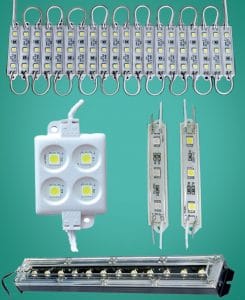 The Indian market has welcomed LED modules based on the latest technology with open arms. But selecting the right LED module can be a daunting task if you are not well aware of its specifications and features
The Indian market has welcomed LED modules based on the latest technology with open arms. But selecting the right LED module can be a daunting task if you are not well aware of its specifications and features
By Shruti Mishra
In recent times, the Indian market has witnessed an exponential growth in the demand for LED lights because of their exceptionally bright light, affordability and environment-friendly features. According to a government report, India sells 770 million LED bulbs every day and about 12 per cent of all the LED lighting systems sold across the world is consumed in India.
As installing and operating them is quite simple, LED lighting systems are today the first choice of many business owners and advertising companies. Yet, the success of LED lights entirely depends upon the quality and efficiency of the LED modules.
An LED module is a self-contained device designed either to function alone or to be pluggable into a compatible unit for power. These modules are commonly used to create energy-efficient or portable lighting. Unlike the conventional lights, LED modules are filament-free and use an electrified semiconductor as their light-emitting material. These modules can be of any colour, depending upon the material used to emit light.
Because of the presence of LED modules, the deterioration caused by heat and light is minimal in LED lights, therfore ensuring a longer operating life cycle compared to other types of lighting, without causing any harm to the environment. On an average, an LED light can offer about 30,000 to 50,000 hours of continuous operation with almost zero maintenance, depending on the quality of LED module used in it.
These modules are designed for a wide variety of lighting purposes like business sign boards, surgical lights, medical ceiling lights, and display lighting for historical monuments. One big advantage of using LED modules for outdoor lighting is that these are completely weatherproof. They can withstand extreme climatic conditions without being damaged at all. Some of the important application areas of LED modules are in hospitality, offices, retail, health care, streetlights, etc.
Technology trends
The use of the latest technology gives LED modules an extra edge over conventional lights. Let’s look at some of the latest technologies involved in the making of LED modules.
- Remote phosphor technology: This reduces the colour shift and heat, while increasing efficiency and the life cycle of the LED modules.
- Plug-and-play technology: LED modules made with this technology have an onboard driver IC that eliminates the hassle of attaching any components externally.
- Bluetooth low energy wireless communication: As the name suggests, this technology offers a low-power wireless LED lighting solution that can connect to billions of devices worldwide. With a single tap on your phone, these LED modules listen directly to switches and sensors.
Quick tips for buyers
In order to pick the right kind of LED modules, always consider the following points:
- The place of installation is an important point that a buyer should keep in mind before choosing any LED module, because the specifications for indoor and outdoor LED modules are quite different. For example, the LED modules used for commercial (outdoor) purposes usually have a high wear-and-tear index compared to the ones used for residential (indoor) purposes. An outdoor LED lighting system comes with a special sun protection feature. Such systems also have high brightness components compared to indoor LED modules, in order to be visible from a greater distance and to contrast from direct sunlight.
- For general outdoor applications, go for LED modules with IP54 or IP55 ratings.
- Always buy LED modules with high correlated colour temperature (CCT), since they are generally more energy-efficient.
- Choose LED modules with a colour rendering index (CRI) close to 90.
- In case of outdoor illumination, choose a compact structure that can increase the scope for design, when working with billboards or signage.
Classification of LED modules
LED modules are broadly classified into two categories.
- According to colour
a. Single colour: An LED lighting module of single colour is usually white, green, yellow or red.
b. RGB LEDs: These are colour-changing modules with various colour emitters. - According to the power of a single LED
a. Low power: Below 0.3W
b. Medium power: Between 0.3W to 0.5W c. High power: 1W and above
Latest launches in this category
Model: Fortimo LED DLM System Gen 4, Manufacturer: Philips
The Fortimo LED downlight module is equipped with a special remote phosphor technology, which enables very high levels of LED efficacy. This general lighting solution builds on the idea of ‘LED systems simplified’. Additionally, the good lumen maintenance and long lifetime of up to 50,000 hours make frequent re-lamping a thing of the past – a promise that is backed up by Philips’ five-year limited warranty.
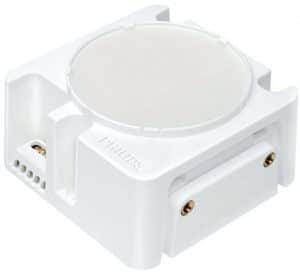 Key features
Key features
- High energy savings compared to compact fluorescent lighting systems (CFLs)
- Superb colour consistency
- An energy-efficient alternative to 18W, 26W, and 2 x 18W CFLs
- Allows for compact heat sink designs
- Allows OEMs to use existing fixtures, heat sinks and reflectors
- No start-up time required
- Reliable and requires minimal maintenance
- Covers two colour temperatures required in downlight applications
- Simple and easy to install
Contact: www.usa.lighting.philips.com
Model: PolyWa OVAL LEDMO, Manufacturer: Kwality Photonics
LEDMO is equipped with a custom silicon lens technology that provides good solutions for street lighting. It consists of an array of either 32, 24 or 18 LEDs; or LEDs similarly connected in three to four strings. Each string of LEDs has a current controlling IC with a negligible voltage drop (to prevent the loss of power and efficiency) in series, and an on-board regulator. Each string draws equal current from the external power supply, which means that all the LEDs operate at the same current, irrespective of individual Vf differences.
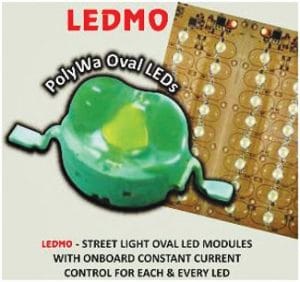 Key features
Key features
- Size: 165mm x 110mm
- Provides homogenous road illumination
- Saves over 15 per cent loss of light
- On-board IC driver
- The turnaround time for such a module design is less than 10 days
Contact: www.kwalityphotonics.com
Model: EdiLex 230V adjustable CCT, Manufacturer: Edison Opto
These modules are designed to be driven directly on AC mains voltage and can be widely used in indoor lighting. Compared to traditional LEDs, Edison Opto’s EdiLex AC modules do not need to connect to an external driver, which reduces the circuit’s cost and the size of the luminaires. There is no need to install expensive dimmers; the switcher can provide a 3-stage dimming function.
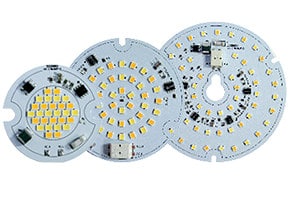 Key features
Key features
- Connects directly to AC mains voltage
- High power efficiency and power factor
- Long lifetime
- Miniaturisation design
- Switch dimming
Contact: www.edison-opto.com
Model: IPLED-2-W, White LED, Manufacturer: IPLED
The IPLED LED modules come with a resin, and are sealed into plastic cases, so they are suitable for outdoor and wet environments. With an IP65 rating, they don’t get hot and are very efficient.
 Key features
Key features
- SMD TOPLED as light source
- Large viewing angle
- Lower light decay and longer life span up to 50,000 hours
- Low cost yet high performance
- Energy saving
- Environment-friendly
- Suitable for backlighting, channel letters and light-boxes
- Waterproof (IP65 rated) and hence ideal for outdoor use
- Easy installation and maintenance-free
Contact: www.ipled.com
Model: Infusion M-series, Manufacturer: GE Lighting
With lumen packages ranging from 1000lm to 4500lm, a choice of colour temperatures, and a wide range of optics, the Infusion M-series offers great versatility, enabling high efficacy solutions for offices, healthcare, hospitality, museums, retail and more. This flexibility, together with the innovative, easy-to-upgrade twist-fit design of the GE Infusion LED module, makes this a popular LED lighting solution on the market.
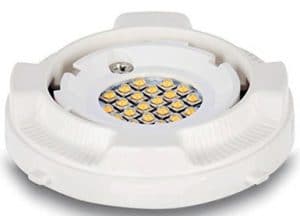 Key features
Key features
- Wide range of different lighting solutions from one platform
- Modular solution for quick, tool-free upgrading
- Lowest cost of ownership in the long term
- Long-term colour consistency
- Five lumen packages ranging from 1000lm to 4500lm
- Four colour temperature options: 2700K, 3000K, 3500K and 4000K for crisp white light
- Exceptionally stable CRI across all colour ratings
- Good lumen maintenance, L85 50,000 hours.
Contact: www.gelighting.com
Model: XIM Generation 4, Manufacturer: Xicato
XIM Gen4 is the latest launch from Xicato that integrates Bluetooth low energy wireless communication, beacon capability and fully-featured light control with one of the industry’s most stringest specifications.
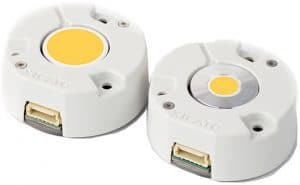 Key features
Key features
- Standard Bluetooth (4.1) wireless connectivity
- Listens directly to switches and sensors
- Embedded Eddyston, iBeacon and/or Alt Beacons
- Up to 400m range, line-of-sight
- -10dBm to +9.5dBm transmit power
- -95dBm receive sensitivity
- > 5:1 signal-to-noise ratio
- Operating temperature: -40˚C to +105˚C
- Spectral band: 2.4GHz
- Bandwidth: 1Mbps
- Channels: 40
Contact: www.xicato.com





























